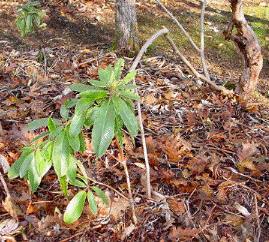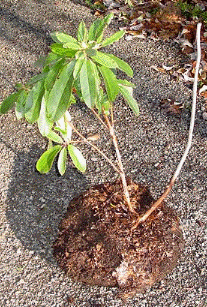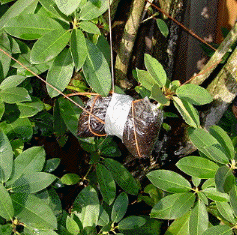Rhododendron Propagation
by Layering
Cuttings*Layering*Seed
Making a Nearing Frame*Preparing the Frame*After
They Are Rooted
| Layering is
one of the easiest ways to propogate rhododendrons. It often
occurs naturally. A branch dips below the surface or is covered
with dirt and forms roots. Eventually the branch can be cut,
and you have a new plant. Although layering is not suited to
high volume production, it is a simple way to a clone of a prized
rhododendron. |
 |
The layered Leona rhododendron
above has been developing roots for three years. It is still connected
to the parent plant by its original branch. Below, the plant was
dug and the branch severed. The stub was left for the picture
to show how breaking the branch enabled it to grow upright. The
healthy rootball makes independent survival likely.
 |
To improve the
odds of success and create a more upright new plant, partially
break the branch at the point you desire the new roots. Dig a
hole and fill it with rooting medium. Treat the break with rooting
hormone and bury the break. Stake the part of the branch past
the break upright. Then go do something else for two or three
years. |
Air layering is a variation
of this type of propagation. Make a cut, slice, or small break
on a branch and treat it with rooting hormone. If you choose a
break, attach a split to hold it all firm in the wind. Mold a
ball of rooting medium around the wound and wrap it in a plastic
bag. Be sure the medium is quite damp but not saturated. Seal
the bag with tape and waiat for the results.
| A healthy Anna
Rose Whitney branch is air layered. Twine secures the bag and
supports the weight. Duct tape seals the package. |
 |
As with cuttings, some kinds
of rhododenddrons root more easily than others. Upright growing
shrubs are naturally less suited to layering in the ground.



